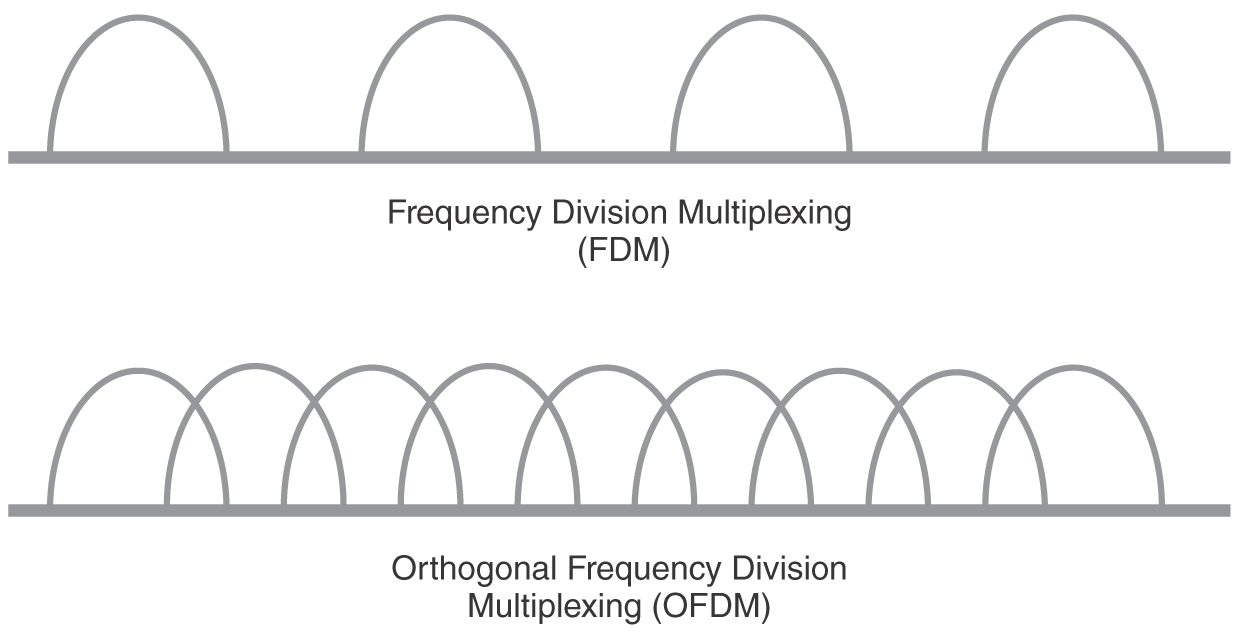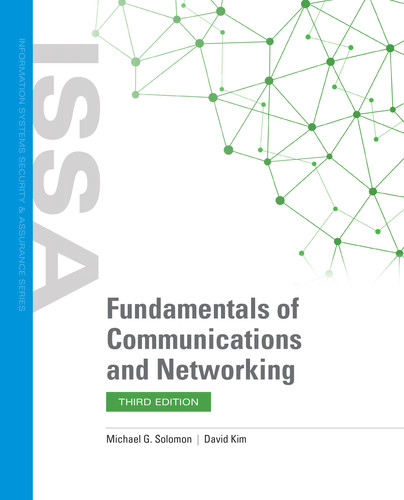IEEE 802.11 Family of Standards
The initial release of the IEEE 802.11 standard (referred to as IEEE 802.11–1999) has been enhanced by other standards to provide increased data speed and greater security. The first widely accepted wireless networking standard was 802.11b, followed by 802.11a, 802.11g, 802.11n, and 802.11ac. Other standards in the family (such as c–f and h–j) are service enhancements and extensions, or corrections to previous specifications. You will read about the basic IEEE 802.11 protocol model in the following sections. This framework is used by the initial and subsequent releases of the IEEE 802.11 standards. The core 802.11 standards that apply directly to wireless networks are listed in TABLE 10-1.
| IEEE STANDARD | DEFINES | APPROVAL DATE |
|---|---|---|
| 802.11 | 2 Mbps wireless networking | 1997 |
| 802.11a | 54 Mbps wireless networking (5 GHz band) | 1999 |
| 802.11b | 11 Mbps wireless networking (2.4 GHz band) | 1999 |
| 802.11g | 54 Mbps wireless networking (2.4 GHz band) | 2003 |
| 802.11i | Security improvements to 802.11x standards | 2004 |
| 802.11n | 600 Mbps wireless networking (2.4 and 5 GHz band) | 2009 |
| 802.11ac | 1300 Mbps wireless networking (5 GHz band) | 2014 |
| 802.11ax | 10,000 Mbps wireless networking (2.4, 5, and 6 GHz band) | 2019 |
| 802.15 | Wireless personal area network (WPAN), a wireless version of a personal area network (PAN) (a network of devices in close proximity to one another) | 2008 |
| 802.16 | WirelessMAN (WMAN)WiMAX | 2005 |
| 802.20 | Fixed wireless broadband | 2004 |
| 802.22 | Wireless regional area network (WRAN) | 2011 |
The 802.11 standards listed together in this table are the wireless LAN (WLAN) technologies; the other 802 standards listed in the table are semi-related to local area networking.
 NOTE
NOTE
You may see wireless standards referred to as 802.11x, which is a generic name for the 802.11 family of standards.
The IEEE 802.11 Legacy Standard
The original WLAN standard was released in 1997 by the IEEE as 802.11, which is now referred to as 802.11 Legacy. The 802.11 standard supported two data transfer speeds—1 or 2 megabits per second (Mbps)—on either infrared (IR) or radio frequency (RF) signals on the 2.4 GHz industrial, scientific, and medical (ISM) bands. This standard was later absorbed into the 802.11b standard.
The IEEE 802.11b WLAN Standard
The IEEE 802.11b WLAN standard, also known as 802.11 High Rate or Wi-Fi, extends the 802.11 standard by improving throughput and increasing data transfer rates to 5.5 Mbps and 11 Mbps. The 802.11b standard operates in the 2.4 to 2.483 GHz unlicensed RF ISM band for either infrastructure (devices communicate indirectly through an access point) or ad hoc (devices communicate directly) mode.
IEEE 802.11b defines the use of a number of technologies and methods, many of which were absorbed into later standards. These technologies include:
- DSSS—Direct sequence spread spectrum (DSSS) transmission is a modulation technique that spreads the transmitted signal over an entire bandwidth to fit the transmitted signal on the carrier.
- Unlicensed CCK—Complementary code keying (CCK) applies mathematical formulas to DSSS codes so they can represent more data per cycle and achieve the higher data rates defined in the 802.11b standard. CCK works only with DSSS.
- QAM—Quadrature amplitude modulation (QAM) combines two amplitude modulation (AM) signals onto a single channel, which effectively doubles the available bandwidth of the channel. The term quadrature refers to the 90-degree (one-quarter-of-a-cycle) phase shifts used to differentiate two carriers.
- DRS—Dynamic rate shifting (DRS) adjusts the transmission rate lower or higher depending on the signal strength or interference. In an electrically noisy environment, or as devices move into or out of range, an 802.11b transmitter adjusts the transmission speed down from 11 Mbps to 5.5 Mbps, 2 Mbps, or 1 Mbps.
An 802.11b infrastructure network includes at least one wireless station and one access point connected to a distribution system. The distribution system is any access device, such as a wired network interface, an Internet bridge or router, or the like.
Wi-Fi Standards
The five IEEE 802.11 standards802.11a, 802.11b, 802.11g, 802.11n, and 802.11acform the Wi-Fi Alliance’s standards for Wi-Fi. The Wi-Fi Alliance was formed when the wireless networking industry began cooperating on a single standard to provide interoperability among the networking devices of different manufacturers. The Wi-Fi Alliance also supports IEEE 802.16 under the marketing name of WiMAX.
The IEEE 802.11a WLAN Standard
The IEEE 802.11a WLAN standards actually preceded the other standards adapted from the 802.11 Legacy standard; however, the 802.11b standard was more widely adopted by manufacturers. The features that set 802.11a apart from 802.11b and 802.11 Legacy are:
- UNII—802.11a operates in the 5 GHz Unlicensed National Information Infrastructure (UNII)band, which eliminates most of the interference problems common to 2.4 GHz systems. Many microwave ovens, cordless telephones, Bluetooth devices, and other consumer electronic products also operate in the 2.4 GHz band.
- OFDM—Orthogonal frequency division multiplexing (OFDM) facilitates up to 54 Mbps of bandwidth, divides a 20 MHz RF channel into 48 narrowband subchannels, and then splits the data signal into 48 separate overlapped carriers—one on each subchannel. This arrangement, shown in FIGURE 10-1, enables OFDM to effectively deal with crosstalk and multipath propagation, which are transmission problems common to Frequency Division Multiplexing (FDM) and other 802.11 standards.
- Multipath propagation—OFDM supports multipath propagation, which is applied when the RF signal cannot take a clear and direct path between a wireless node and the access point. RF signals may not be able to take direct paths due to objects such as walls, chairs, and desks, which can deflect or diffuse the signal. When this happens, only a portion of a signal arrives at the receiver, with the remainder of the signal deflected to an indirect route. This may cause a delay between the two (or more) parts of the signal of as much as 50 to 300 nanoseconds, depending on the environment. When multipath propagation occurs, the delayed signal segments may overlap another discrete signal.
- IEEE 802.11a modulation—802.11a modulates digital data based on the data transfer rate in use:
- Binary phase shift keying (BPSK)—This form of modulation allows higher data rates to be carried within a given bandwidth.
- QAM—At 54 Mbps, the 802.11a applies QAM to vary the signal on different amplitude levels and phase shifting.

FIGURE 10-1 A comparison of how FDM and OFDM modulate a signal for transmission.
Data from IdeaData.
Technical TIP
IEEE 802.11a is incompatible with WLAN systems that operate on the ISM band, including 802.11b and 802.11g.
 NOTE
NOTE
Frequency division multiplexing (FDM) transmits multiple signals simultaneously over a single transmission medium, each of which travels within its own frequency range.
The IEEE 802.11g WLAN Standard
The IEEE 802.11g standard supports high-speed (up to 54 Mbps) wireless networking over relatively short distances. The 802.11g standard operates on the same RF bands as 802.11b, but incorporates OFDM to achieve the higher data transfer rates. When the communication distance increases or the signal becomes compromised, 802.11g can scale the transmission speeds back down to the 11 Mbps of the 802.11b standard or even lower. The 802.11b and 802.11g devices are compatible within a single WLAN because 802.11g hardware is fully backward compatible with 802.11b hardware.
The IEEE 802.11n WLAN Standard
The IEEE 802.11n standard increases the throughput of the 802.11g standard to 450 Mbps by using multiple wireless signals and antennas. IEEE 802.11n applies multiple-input and multiple-output (MIMO), an antenna technology that uses multiple antennas (to receive and transmit) at both ends of a transmission. Originally a broadcast radio technology, MIMO was integrated into WLAN communications to improve data throughput and range without changing the nominal bandwidth or transmission power of WLAN devices.
The IEEE 802.11ac WLAN Standard
The IEEE 802.11ac standard provides another increase in speed, with up to 1300 Mbps throughput. It extends the design concepts of 802.11n with an RF bandwidth up to 160 MHz and more MIMO spatial streams, and adds high-density modulation in the form of 256 QAM. The 802.11ac standard provides a 33 percent improvement in data rate. The 802.11ac standard operates in the 5 GHz band, which is less crowded than the 2.4 GHz band.
The IEEE 802.11ax WLAN Standard
The IEEE 802.11ax standard, also marketed as Wi-Fi 6, is the latest standard in the 802.11 family, providing up to 10,000 Mbps throughput. It extends the design concepts of 802.11n and 802.11ac with an RF bandwidth up to 160 MHz and more MIMO and MU-MIMO spatial streams (more on these later), and adds high-density modulation in the form of 1024 QAM. All Wi-Fi 6 802.11ax devices operate in the 2.4 GHz and 5 GHz bands, and Wi-Fi 6E devices also operate in the 6 GHz band.
Frequencies: 2.4 GHz/5.0 GHz/6.0 GHz
Most 802.11 devices operate in the 2.4 GHz or 5.0 GHz frequency band. The 2.4 GHz band was the most popular band for early wireless devices and quickly became crowded. The 2.4 GHz band consists of only 14 channels, 11 of which are used in the United States. Interference is common because wireless devices of many types use the narrow range of channels.
To avoid the congestion of the 2.4 GHz band, newer wireless standards, starting with 802.11a in 1999, began using the 5 GHz band for signaling. Using the higher frequency band separated devices from those using the more crowded lower frequencies. Additionally, the 5 GHz band has nearly 200 available channels, which makes it even less crowded.
The latest 802.11 standard to be released (as of the time of publication) is 802.11ax, which provides support for a new frequency band, 6 GHz. This new band provides greater bandwidth and less congestion than even the 5 GHz band.
Data from National Institute of Standards and Technology
Data Speeds Versus Throughput
Don’t confuse data transfer speed and throughput. Data speed is a function of both the media and the capabilities of the transmission devices in use. The maximum rate that bits can be transmitted across a medium and supported by the transmitting equipment is the maximum data transfer speed. On the other hand, throughput is the measure of the actual data transfer speed realized by the user.
A network is rarely able to achieve the rated speed of its medium. This is because of the protocol’s bandwidth requirements or the overhead (lag time) of the transmission processes themselves. For example, an 802.11b device, with a maximum rated speed of 11 Mbps, typically yields only about 6 Mbps of actual throughput, and this would be true only under the ideal conditions of distance and signal quality. IEEE 802.11a and 802.11g, with data speeds up to 54 Mbps, can deliver throughput speeds of between 18 and 22 Mbps in ideal communication conditions.
Distance is perhaps the biggest detriment to throughput. If the wireless station and the access point are sitting side by side, data speed and throughput should be optimal; however, as the two devices move farther apart, the transmission speed decreases, and throughput declines right along with it. Other factors can also affect throughput, including solid objects in the signal’s path, such as wood, metal, concrete, wiring, and other construction materials.
